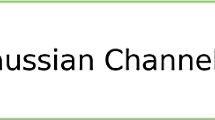Abstract
In this paper, we treat the quantum filtering problem for multiple input multiple output (MIMO) Markovian open quantum systems coupled to multiple boson fields in an arbitrary zero-mean jointly Gaussian state, using the reference probability approach formulated by Bouten and van Handel as a quantum version of a well-known method of the same name from classical nonlinear filtering theory, and exploiting the generalized Araki-Woods representation of Gough. This includes Gaussian field states such as vacuum, squeezed vacuum, thermal, and squeezed thermal states as special cases. The contribution is a derivation of the general quantum filtering equation (or stochastic master equation as they are known in the quantum optics community) in the full MIMO setup for any zero-mean jointly Gaussian input field states, up to some mild rank assumptions on certain matrices relating to the measurement vector.
Similar content being viewed by others
References
V. P. Belavkin, Optimal Measurement and Control in Quantum Dynamical Systems (Institute of Physics, Nicolaus Copernicus University, Torun, preprint 411, 1979).
V. Belavkin, “On the Theory of Controlling Observable Quantum Systems,” Automation and Remote Control 44(2), 178–188 (1983).
V. Belavkin, “Quantum Stochastic Calculus and Quantum Nonlinear Filtering,” J. Multivariate Anal. 42, 171–201 (1992).
V. Belavkin, “Quantum Continual Measurements and A Posteriori Collapse On CCR,” Commun. Math. Phys. 146, 611–635 (1992).
J. Dailbard, Y. Castin, and K. Mølmer, “Wave-Function Approach to Dissipative Processes in Quantum Optics,” Phys. Rev. Lett. 68(5), 580–583 (1992).
R. Dum, P. Zoller, and H. Ritsch, “Monte Carlo Simulation of the Atomic Master Equation for Spontaneous Emission,” Phys. Rev. A 45(7), 4879–4887 (1992).
H. J. Carmichael, “Quantum Trajectory Theory for Cascaded Open Systems,” Phys. Rev. Lett. 70, 2273–2276 (1993).
H. Carmichael, An Open Systems Approach to Quantum Optics (Berlin: Springer, 1993).
L. Bouten, Filtering and Control in Quantum Optics (Ph.D. dissertation, Catholic University of Nijmegen, 2004).
J. Gough and C. Kostler, “Quantum Filtering in Coherent States,” Communications on Stochastic Analysis 4(4), 505–521 (2010).
J. E. Gough, M. R. James, and H. I. Nurdin, “Quantum Filtering for Systems Driven by Fields in Single Photon States and Superposition of Coherent States Using Nonmarkovian Embeddings,” Quantum Inf Process 12, 1469–1499 (2013).
J. Gough, M. R. James, H. I. Nurdin, and J. Combes, “Quantum Filtering for Systems Driven by Fields in Single-Photon States or Superposition of Coherent States,” Phys. Rev. A 86, pp. 043819 (2012).
H. Song, G. Zhang, and Z. Xi, Multi-Photon Filtering (arXiv preprint arXiv:1307.7367, 2013).
J. E. Gough, M. R. James, and H. I. Nurdin, Quantum Trajectories for a Class of Continuous Matrix Product Input States New J. Phys. 16, 075008 (2014).
M. G. Genoni, S. Mancini, and A. Serafini, General-Dyne Unravelling of a Thermal Master Equation (arXiv preprint arXiv:1405:3565v1, 2014).
H. M. Wiseman and G. J. Milburn, Quantum Measurement and Control (Cambridge University Press, 2010).
A. Chia and H. M. Wiseman, “Quantum Theory of Multiple-Input-Multiple-Output Markovian Feedback With Diffusive Measurements,” Phys. Rev. A 84, 012120 (2011).
J. E. Gough, M. R. James, and H. I. Nurdin, “Squeezing Components in Linear Quantum Feedback Networks,” Phys. Rev. A 81, 023 804-1–023804-15 (2010).
R. L. Hudson and K. R. Parthasarathy, “Quantum Ito’s Formula and Stochastic Evolution,” Commun. Math. Phys. 93, 301–323 (1984).
K. Parthasarathy, An Introduction to Quantum Stochastic Calculus (Berlin: Birkhauser, 1992).
P. A. Meyer, Quantum Probability for Probabilists (2nd ed. Berlin-Heidelberg: Springer-Verlag, 1995).
J. Gough, “Quantum White Noise and the Master Equation for Gaussian Reference States,” Russ. Journ. Math. Phys. 10(2), 142–148 (2003).
H. Hellmich, R. Honegger, C. Köstler, B. Kümmerer, and A. Rieckers, “Couplings to Classical and Non-Classical Squeezed White Noise as Stationary Markov Processes,” Publ. RIMS, Kyoto Univ. 38, 1–31 (2002).
L. Bouten and R. van Handel, Quantum Filtering: A Reference Probability Approach (arXiv preprint arXiv:math-ph/0508006v4, 2006).
L. Bouten and R. van Handel, “On the Separation Principle of Quantum Control,” in Quantum Stochastics and Information: Statistics, Filtering and Control (University of Nottingham, UK, 15–22 July 2006), V. P. Belavkin and M. Guta, Eds. Singapore: World Scientific, 206–238 (2008).
L. Bouten, R. van Handel, and M. R. James, “An Introduction to Quantum Filtering,” SIAM J. Control Optim. 46, 2199–2241 (2007).
H. I. Nurdin, “Network Synthesis of Mixed Quantum-Classical Linear Stochastic Systems,” in Proceedings of the 2011 Australian Control Conference (AUCC). Engineers Australia, 68–75 (2011).
S. Wang, H. I. Nurdin, G. Zhang, and M. R. James, Network Synthesis for a Class of Mixed Quantum-Classical Linear Stochastic Systems (arXiv preprint arXiv:1403.6928v2).
J. Gough and M. R. James, “The Series Product and Its Application to Quantum Feedforward and Feedback Networks,” IEEE Trans. Automat. Contr. 54(11), 2530–2544 (2009).
Author information
Authors and Affiliations
Corresponding author
Additional information
Dedicated to the memory of Slava Belavkin
Research supported by the Australian Research Council
Rights and permissions
About this article
Cite this article
Nurdin, H.I. Quantum filtering for multiple input multiple output systems driven by arbitrary zero-mean jointly Gaussian input fields. Russ. J. Math. Phys. 21, 386–398 (2014). https://doi.org/10.1134/S106192081403011X
Received:
Published:
Issue Date:
DOI: https://doi.org/10.1134/S106192081403011X



